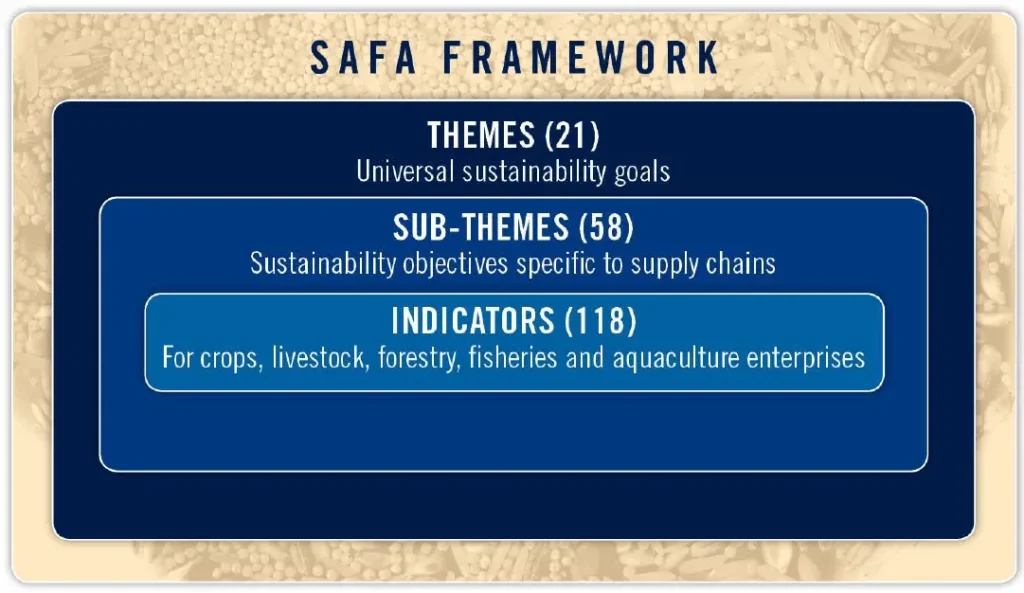At MAN-UNITED, our mission is to help food and agriculture businesses thrive sustainably. As part of our commitment to transparency and continuous improvement, we are launching a blog series to introduce key concepts behind sustainability assessment in agriculture and food systems.
In this first post, we explore the origins of the SAFA (Sustainability Assessment of Food and Agriculture Systems) Guidelines, a global reference framework developed by the Food and Agriculture Organization (FAO) of the United Nations. SAFA is central to our work at MAN-UNITED, and understanding its background helps us appreciate its value for our clients, partners, and the planet.
Why SAFA Was Needed
In recent decades, claims of “sustainability” in food production have multiplied. Yet, many of these claims were fragmented—focused only on environmental impacts, or limited to corporate social responsibility, or inconsistently measured across different sectors. Without a unified framework, it was difficult for stakeholders to compare practices, trust labels, or benchmark real progress.
That is where SAFA comes in.
The SAFA Guidelines provide a holistic, transparent, and science-based framework to assess sustainability in agriculture and food systems. It integrates four pillars of sustainability:
- Good Governance
- Environmental Integrity
- Economic Resilience
- Social Well-being
With these dimensions, SAFA addresses sustainability not as a buzzword, but as a comprehensive performance standard for farms, agribusinesses, cooperatives, and even multinational supply chains.
The Birth of SAFA: A Multi-Stakeholder Journey
The story of SAFA began in 2009, when the FAO initiated collaboration with the ISEAL Alliance, a global leader in sustainability standards. This early phase involved:
- A deep review of international sustainability literature and frameworks (such as the Brundtland Report and Walmart’s sustainability index),
- Two expert meetings to define the key principles of sustainability in agriculture,
- A recognition that existing tools were either too narrow or not aligned with FAO’s broad vision for global food security and sustainable development.
In early 2011, a first draft of a sustainability framework and a candidate set of indicators were developed by FAO experts. To ensure this wasn’t just a top-down exercise, FAO launched the first global e-Forum, inviting farmers, scientists, NGOs, companies, and policymakers to give feedback.
The response was extraordinary: 246 participants from 61 countries contributed comments and insights. This participatory process ensured the SAFA framework was grounded in the realities of producers, not just policy theories.
Evidence-Based Refinement
Following the initial e-Forum, FAO partnered with the Swiss College of Agriculture and FiBL to conduct:
- A stakeholder survey,
- A benchmarking comparison of over 40 existing sustainability standards and initiatives.
This revealed gaps, duplications, and strengths across global sustainability systems. The feedback affirmed the need for a single, well-structured framework that organizations could trust and adopt worldwide.
In early 2012, FAO hosted a second expert meeting and another e-Forum to refine the guidelines. Stakeholders were especially focused on making the SAFA framework adaptable to different cultural, geographic, and business contexts—without losing its integrity.
Testing SAFA in the Real World
SAFA was not built in isolation. Before its official release, it was pilot-tested in more than 30 agricultural enterprises worldwide, including farms, cooperatives, and processors.
These pilot programs helped fine-tune the indicators, themes, and assessment procedures. By mid-2012, the framework was solid enough to be presented during the Rio+20 Earth Summit, one of the most important sustainability conferences in history.
In 2013, the finalized SAFA Guidelines and SAFA Tool were publicly released. They are available free of charge and continue to evolve through user feedback and expert consultation.
What Is SAFA Today?
Today, SAFA stands as one of the most comprehensive sustainability assessment frameworks for the agriculture and food sector.
It breaks down sustainability into 4 dimensions, 21 themes, and 58 sub-themes, each with well-defined goals, indicators, and metrics. SAFA enables organizations to:
- Map their operations,
- Select relevant indicators,
- Generate objective sustainability reports,
- Benchmark against global best practices.
Whether you are a family-owned farm or a large agro-industrial operation, SAFA helps you identify strengths, uncover risks, and implement continuous improvement strategies.

What SAFA Means for Your Business
For food and agriculture companies seeking to operate responsibly and build long-term trust with customers, investors, and regulators, SAFA offers a clear, credible, and practical roadmap.
At MAN-UNITED, we specialize in helping you implement SAFA-based assessments and achieve internationally recognized sustainability certification. Our services include gap analysis, training, audit preparation, and compliance support—all grounded in the SAFA framework.
By adopting SAFA, your business can:
- Improve efficiency and transparency,
- Align with global sustainability goals (e.g., SDGs),
- Strengthen brand value in local and international markets.

Stay Tuned
This blog series will continue to unpack key elements of SAFA, including how to apply its four dimensions, and how companies like yours can benefit from our support.
At MAN-UNITED, we believe that sustainability is not a destination—it’s a journey we walk together.
Thank you for joining us at the starting point.
Learn more about our services or Contact Us to start your SAFA-based sustainability journey today.

